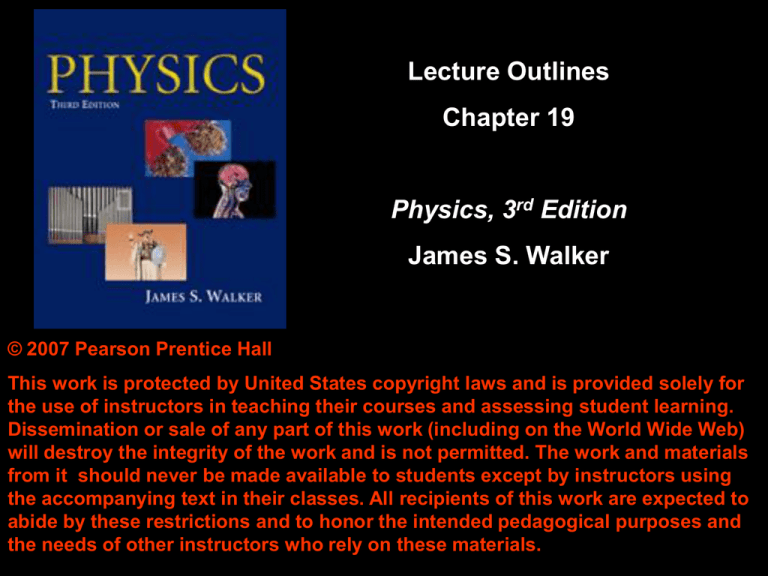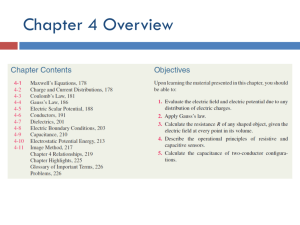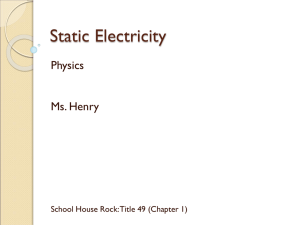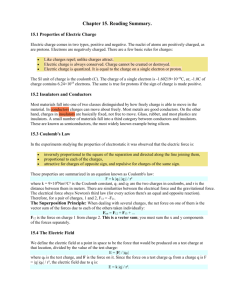
Lecture Outlines
Chapter 19
Physics, 3rd Edition
James S. Walker
© 2007 Pearson Prentice Hall
This work is protected by United States copyright laws and is provided solely for
the use of instructors in teaching their courses and assessing student learning.
Dissemination or sale of any part of this work (including on the World Wide Web)
will destroy the integrity of the work and is not permitted. The work and materials
from it should never be made available to students except by instructors using
the accompanying text in their classes. All recipients of this work are expected to
abide by these restrictions and to honor the intended pedagogical purposes and
the needs of other instructors who rely on these materials.
Chapter 19
Electric Charges, Forces,
and Fields
Units of Chapter 19
• Electric Charge
• Insulators and Conductors
• Coulomb’s Law
• The Electric Field
• Electric Field Lines
• Shielding and Charging by Induction
• Electric Flux and Gauss’s Law
19-1 Electric Charge
The effects of electric charge were first
observed as static electricity:
After being rubbed on a
piece of fur, an amber
rod acquires a charge
and can attract small
objects.
19-1 Electric Charge
Charging both amber and glass rods shows
that there are two types of electric charge; like
charges repel and opposites attract.
19-1 Electric Charge
All electrons have exactly the same charge;
the charge on the proton (in the atomic
nucleus) has the same magnitude but the
opposite sign:
19-1 Electric Charge
The electrons in an atom are in a cloud
surrounding the nucleus, and can be separated
from the atom with relative ease.
19-1 Electric Charge
When an amber rod is
rubbed with fur, some of
the electrons on the
atoms in the fur are
transferred to the amber:
19-1 Electric Charge
We find that the total electric charge of the
universe is a constant:
Electric charge is conserved.
Also, electric charge is quantized in units of e.
The atom that has lost an electron is now
positively charged – it is a positive ion
The atom that has gained an electron is now
negatively charged – it is a negative ion
19-1 Electric Charge
Some materials can become
polarized – this means that their
atoms rotate in response to an
external charge. This is how a
charged object can attract a
neutral one.
19-2 Insulators and Conductors
Conductor: A material whose conduction
electrons are free to move throughout. Most
metals are conductors.
Insulator: A material whose electrons seldom
move from atom to atom. Most insulators are
non-metals.
19-2 Insulators and Conductors
If a conductor carries
excess charge, the
excess is distributed
over the surface of the
conductor.
19-2 Insulators and Conductors
Semiconductors have properties intermediate
between conductors and insulators; their
properties change with their chemical
composition.
Photoconductive materials become
conductors when light shines on them.
19-3 Coulomb’s Law
Coulomb’s law gives the force between two
point charges:
The force is along the line connecting the
charges, and is attractive if the charges are
opposite, and repulsive if the charges are like.
19-3 Coulomb’s Law
The forces on the two charges are actionreaction forces.
19-3 Coulomb’s Law
If there are multiple point charges, the forces
add by superposition.
19-3 Coulomb’s Law
Coulomb’s law is stated in terms of point
charges, but it is also valid for spherically
symmetric charge distributions, as long as the
distance is measured from the center of the
sphere.
19-4 The Electric Field
Definition of the electric field:
Here, q0 is a “test charge” – it serves to allow
the electric force to be measured, but is not
large enough to create a significant force on
any other charges.
19-4 The Electric Field
If we know the electric field, we can calculate the
force on any charge:
The direction of the
force depends on the
sign of the charge – in
the direction of the field
for a positive charge,
opposite to it for a
negative one.
19-4 The Electric Field
The electric field of a point charge points radially
away from a positive charge and towards a
negative one.
19-4 The Electric Field
Just as electric forces can be superposed,
electric fields can as well.
19-5 Electric Field Lines
Electric field lines are a convenient way of
visualizing the electric field.
Electric field lines:
1. Point in the direction of the field vector at
every point
2. Start at positive charges or infinity
3. End at negative charges or infinity
4. Are more dense where the field is stronger
19-5 Electric Field Lines
The charge on the right is twice the magnitude
of the charge on the left (and opposite in sign),
so there are twice as many field lines, and they
point towards the charge rather than away
from it.
19-5 Electric Field Lines
Combinations of charges. Note that, while the lines
are less dense where the field is weaker, the field is
not necessarily zero where there are no lines. In
fact, there is only one point within the figures
below where the field is zero – can you find it?
19-5 Electric Field Lines
A parallel-plate
capacitor consists of
two conducting plates
with equal and opposite
charges. Here is the
electric field:
19-6 Shielding and Charge by Induction
Since excess charge on a
conductor is free to move, the
charges will move so that they
are as far apart as possible.
This means that excess
charge on a conductor resides
on its surface, as in the upper
diagram.
19-6 Shielding and Charge by Induction
When electric charges are at rest, the electric
field within a conductor is zero.
19-6 Shielding and Charge by Induction
The electric field is always perpendicular to the
surface of a conductor – if it weren’t, the
charges would move along the surface.
19-6 Shielding and Charge by Induction
The electric field is stronger where the surface is
more sharply curved.
19-6 Shielding and Charge by Induction
A conductor can be charged by induction, if there
is a way to ground it.
This allows the like
charges to leave the
conductor; if the
conductor is then
isolated before the
rod is removed,
only the excess
charge remains.
19-7 Electric Flux and Gauss’s Law
Electric flux is a measure of the electric field
perpendicular to a surface:
19-7 Electric Flux and Gauss’s Law
Gauss’s law states that the electric flux through
a closed surface is proportional to the charge
enclosed by the surface:
19-7 Electric Flux and Gauss’s Law
Gauss’s law can be used to find the electric
field in systems with simple configurations.
Summary of Chapter 19
• Electrons have a negative charge, and protons
a positive charge, of magnitude
• Unit of charge: Coulomb, C
• Charge is conserved, and quantized in units
of e
• Insulators do not allow electrons to move
between atoms; conductors allow conduction
electrons to flow freely
Summary of Chapter 19
• The force between electric charges is along
the line connecting them
• Like charges repel, opposites attract
• Coulomb’s law gives the magnitude of the
force:
• Forces exerted by several charges add as
vectors
Summary of Chapter 19
• A spherical charge distribution behaves from
the outside as though the total charge were at
its center
• Electric field is the force per unit charge; for a
point charge:
• Electric fields created by several charges add
as vectors
Summary of Chapter 19
• Electric field lines help visualize the electric
field
• Field lines point in the direction of the field;
start on + charges or infinity; end on – charges
or infinity; are denser where E is greater
• Parallel-plate capacitor: two oppositely
charged, conducting parallel plates
• Excess charge on a conductor is on the surface
• Electric field within a conductor is zero (if
charges are static)
Summary of Chapter 19
• A conductor can be charged by induction
• Conductors can be grounded
• Electric flux through a surface:
• Gauss’s law:








